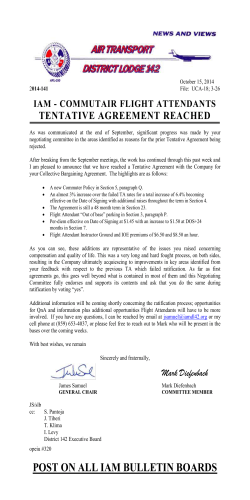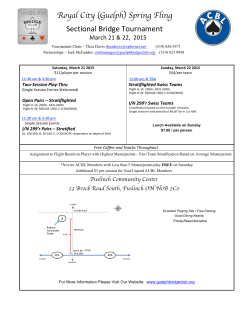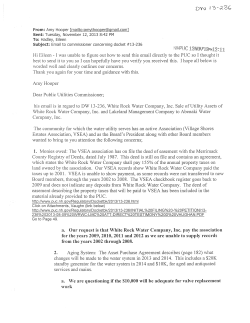
Physics Challenge for Teachers and Students Solution to September 2014 Challenge
Physics Challenge for Teachers and Students Boris Korsunsky, Column Editor Weston High School, Weston, MA 02493 korsunbo@post.harvard.edu Solution to September 2014 Challenge w The second half of the flight A rock is thrown vertically. During the last second of its flight, it covers half the total distance traveled. What is the maximum possible flight time for the rock? Assume that the acceleration due to gravity is 10 m/s2. (Adapted from Olympiadnye Zadachi po Fizike, M. Bakunov, S. Biragov, R&C Dynamics, Moscow, 2006) Again note that both terms on the RHS of Eq. (2) are manifestly positive. Despite the devious wording of the problem, quite a few readers solved the problem correctly. We received many solutions in which the contributors chose to explore the problem further. Here is one such solution. Qualitative analysis For maximum flight time we want to arrange both that the distance traveled in the last second is “large” and that the average speed before that was “small.” Together these characteristics will produce a long flight time before the last second begins. The first of these requirements will be best met if the rock is thrown upward, slows to momentary rest, and then falls some distance before the last second of the flight begins.The second suggests that the rock should spend most of the time before the last second falling from its highest point so that the last second begins with as high a speed as possible. As we’ll see, that is precisely the case. Solution: Let v1 be the velocity at the beginning of the last second (the “intermediate velocity”) and assume, as explained above, that it is downward, which we will take to be negative, we find the distance d traveled during the last second to be 1 (1) d = −v1t + g t 2 , 2 where t 1 s and g 10 m/s2. Note that both terms on the RHS of Eq. (1) are manifestly positive. Next, assuming (as explained above) that the rock was initially thrown upward with velocity v0 > 0, the distance traveled before the beginning of the final second (specified in the problem statement to be equal to d) is the sum of the distances traveled while rising and while falling, The Physics Teacher ◆ Vol. 52, 2014 d= v02 v12 + . 2g 2g (2) Finally, the total flight time T is given by the sum of the rising and falling times before the last second plus one second. That is, v −v T = 0 + 1 + t. (3) g g We extremize T by setting dT/dv1 = 0, which yields dv 0 = 1. (4) dv1 Eliminating d between Eqs. (1) and (2) and solving for v0, we find (5) v0 = g2 t 2 − 2 gt v1 − v12 , so that Eq. (4) becomes v1(v1 + 2gt) = 0, (6) which has two roots, v1 = 0 and v1 = –2gt. (7) The first of these is the upper boundary of the range for which our analysis is valid. We reject it both because the derivative in Eq. (4) is not well-defined at that point and because it violates our intuition that v1 should be strictly and substantially negative. Thus, with the help of Eq. (5), we find v1 = – 2gt = –20 m/s and v0 = gt = 10 m/s, and, from Eq. (3), Tmax = T v1 = −2 gt = 4t = 4 s. Discussion (8) (9) The total time of flight T, the “last second distance” d, and the initial velocity v0 are all uniquely determined by the intermediate velocity v1. The reverse, however, is not true. For instance, there is a range of initial velocities, specifically from v0 = 200 / 3 m/s ≈ 8.16 m/s to v0 = 200 m/s ≈ 14.14 m/s (the derivation of these values, and the rest of the analysis here is left as an exercise for the reader), for which the conditions of the problem are satisfied for three different values of v1 and associated values of d and T. In case (a), the rock is shot upward, and the total distance D it travels is represented by the area A + (B + C) under the graph, given by The figure below illustrates the multi-valued nature of the dependence of the total time of flight on the initial velocity. Note especially that, while the maximum time of flight occurs for an initial velocity of 10 m/s with where k is a proportionality constant, common to all triangles in both figures, by the similarity of the formers. Moreover, according to the problem, the distance C traveled during the last second is equal to B + A, and by the similarity of triangles, we have 1) an intermediate velocity of –20 m/s and a total time of flight of 4 s (5 m up and 20 m down followed by 25 m down in the final second), Time of Flight versus Initial Velocity 3.500 3.000 In case (b), on the other hand, the rock is shot downward, and from Fig. (b) it is readily seen that 2.500 2.000 D = k[(t –T)2 – T2] and C = k[(t – 1 – T)2 – T2], 1.500 which, together with D = 2C, yields 1.000 0.500 t = T + 2 + T 2 + 2, t = T + 2 − T 2 + 2, T ≤ 0. 0.000 -10.000 0.000 Equating D to 2C and solving for t, we find Since we are looking for the maximum t, the second root is of no interest, while the first one attains a maximum t = 4 s at T = 1 s. 4.000 -20.000 C = k [T2 + (t –1 – T)2]. t = T + 2 + −T 2 + 2, t = T + 2 − −T 2 + 2, T ≥ 0. 4.500 -30.000 D = k [T2 + (t – T)2], 10.000 20.000 30.000 Initial Velocity (m/s) there are two other, lesser total time-of-flight scenarios that also satisfy the problem statement. One has 2) an intermediate velocity of 0 and a total time of flight of 2 s (5 m up followed by 5 m down) and the other has 3) an intermediate velocity of 20/3 < 6.67 m/s and a total time of flight of 4/3 < 1.33 s (25/9 m up followed by another 20/9 m up and 5/9 m down during the final second). (Contributed by John Mallinckrodt, Cal Poly Pomona, Pomona, CA) We again may ignore the second root. As to the first, it is a strictly increasing function of T which attains a maximum of 2 + 2 at T = 0 ; this seems intuitively clear, for the closer T to zero, the lower the initial speed and the longer it takes the rock to cover the first half of the total distance covered. Combining both results, we conclude that the maximum flight time is four seconds. It is interesting to note that the answer is independent of the acceleration due to gravity. (Submitted by Joseph Rizcallah, Sagesse High School, Ain Saadeh, Lebanon) We also recognize the following contributors: Salvatore Basile (Università degli Studi di Palermo, Palermo, Italy) Philip Blanco (Grossmont College, El Cajon, CA) Speed Speed Don Easton (Lacombe, Alberta, Canada) Gerald E. Hite (TAMUG, Galveston, TX) Art Hovey (Galvanized Jazz Band, Milford, CT) C C A B Time Time David Jones (Florida International University, 0 t -1 t 0 t T T t -1 Miami, FL) (a) (b) José Ignacio Íñiguez de la Torre (Universidad de The figure above shows the speed-time graph of the Salamanca, Salamanca, Spain) motion of the rock, with T being the time (possibly Jarrett L. Lancaster (University of North Carolina at negative if the rock is shot downward, as shown in Fig. Greensboro, Greensboro, NC) (b)) the rock reaches the maximum height and t is the Matthew W. Milligan (Farragut High School, Knoxtotal time of flight. ville, TN) And here is an alternative solution that uses a geometric approach: The Physics Teacher ◆ Vol. 52, 2014 Daniel Mixson (Naval Academy Preparatory School, Newport, RI) Carl E. Mungan (U. S. Naval Academy, Annapolis, MD) Pascal Renault (John Tyler Community College, Midlothian, VA) Ryan Yancey (Lancaster High School, Lancaster, CA) Guidelines for contributors: – We ask that all solutions, preferably in Word format, be submitted to the dedicated email address challenges@ aapt.org. Each message will receive an automatic acknowledgment. – The subject line of each message should be the same as the name of the solution file. – The deadline for submitting the solutions is the last day of the corresponding month. 464 The Physics Teacher ◆ Vol. 52, 2014 – Each month, a representative selection of the successful solvers’ names will be published in print and on the web. – If your name is—for instance—Bilbo Baggins, please name the file “Nov14Baggins” (do not include your first initial) when submitting the November solution. – If you have a message for the Column Editor, you may contact him at korsunbo@post.harvard.edu; however, please do not send your solutions to this address. As always, we look forward to your contributions and hope that they will include not only solutions but also your own Challenges that you wish to submit for the column. Boris Korsunsky, Column Editor
© Copyright 2025












![How to Improve Your Vacation ail] PMC Pharmacy](http://cdn1.abcdocz.com/store/data/000192727_1-2f9a1cabe19c82865510acaa05c88673-250x500.png)








